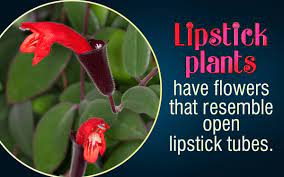Introduction
Lipstick plants, with their vibrant hues and unique charm, have become a popular choice among plant enthusiasts. Moreover, it enhances the beauty of a garden. In this comprehensive guide, we’ll delve into the various aspects of lipstick plants, exploring their uses, and types, and providing a step-by-step guide on how to grow and care for these fascinating botanical wonders.
A Brief History of Lipstick Plants

Origins and Discovery
The lipstick plant, Aeschynanthus radicans, was first discovered in Southeast Asia, particularly in countries like Malaysia and Indonesia. Meanwhile, The box-leaf lipstick plant, scientifically known as Aeschynanthus buxifolius, belongs to the Gesneriaceae family and is indigenous to southern China and northern Vietnam.
Its journey into the world of horticulture began as botanists marveled at its unique tubular flowers resembling a tube of lipstick.
Journey to Global Popularity
Introduced to the Western world in the 19th century, the lipstick plant quickly gained popularity for its striking appearance and ease of care. Since then, it has become a cherished addition to households worldwide, contributing to the rich tapestry of botanical history.

Understanding the Uses of Lipstick Plant
Ornamental Appeal
The lipstick plant, scientifically known as Aeschynanthus radicans, is primarily cultivated for its ornamental beauty. The vivid red, tubular flowers resemble a tube of lipstick, adding a touch of elegance to any indoor space.
Feng Shui Significance
Feng Shui enthusiasts believe that lipstick plants bring positive energy and good fortune into a home. Their vibrant colors are thought to promote harmony and attract prosperity, making them a popular choice for interior decoration.
Exploring Different Types of Lipstick Plants
Aeschynanthus Radicans Varieties
Lipstick plants come in various species and hybrids. Aeschynanthus radicans boasts different varieties, each showcasing unique flower colors and leaf patterns. From deep reds to coral pinks, the diversity within this species allows plant enthusiasts to choose a lipstick plant that suits their aesthetic preferences.
Other Lipstick Plant Varieties
Beyond Aeschynanthus radicans, there are additional lipstick plant species such as Aeschynanthus pulcher, offering a broader spectrum of colors and growth habits. Exploring these varieties opens up exciting possibilities for plant collectors.
Step-by-Step Guide to Growing and Caring for Lipstick Plants

Choosing the Right Soil
Lipstick plants thrive in well-draining soil that mimics their native tropical habitat. A mix of peat moss, perlite, and orchid bark creates an ideal environment for these plants to flourish.
Optimal Light Conditions
Provide your lipstick plant with bright, indirect light. While they can tolerate some shade, too much direct sunlight can scorch their delicate leaves. Finding the right balance is crucial for their overall health.
Watering Techniques
Like many tropical plants, lipstick plants prefer consistently moist soil. However, they are susceptible to root rot, so it’s essential to let the top inch of soil dry out before watering again.
Humidity Matters
Mimicking the humidity of their natural habitat is key to keeping lipstick plants thriving. Regular misting or placing a tray of water near the plant can help maintain the optimal humidity levels.
Pruning for Shape
Regular pruning encourages a fuller, bushier growth. Trim back leggy stems and spent flowers to maintain the plant’s desired shape and promote new growth.
Fertilizing Routine
During the growing season, provide a balanced liquid fertilizer every 4-6 weeks. This helps replenish the nutrients in the soil, supporting the plant’s overall well-being.
Common Factors Affecting Lipstick Plants
Pest Infestations
Aphids and spider mites are common nuisances for lipstick plants. Regular inspection and the application of neem oil can help combat these pests effectively.
Temperature Sensitivity
Lipstick plants are sensitive to temperature fluctuations. Avoid exposing them to drafts or sudden temperature drops, as this can lead to stress and adversely affect their growth.
Root-bound Issues
As lipstick plants grow, they may become root-bound in their containers. Transplanting into a slightly larger pot every 2-3 years helps prevent this issue and ensures continued healthy growth.
Overwatering Pitfalls
One of the most common mistakes in caring for lipstick plants is overwatering. Too much moisture can lead to root rot and other fungal diseases. Monitoring soil moisture levels is crucial for preventing such issues.
Finale
In conclusion, the lipstick plant, with its stunning appearance and unique characteristics, is a delightful addition to any plant lover’s collection. By understanding its uses, exploring different varieties, and following a comprehensive care guide, you can ensure that your lipstick plant thrives and continues to grace your living space with its natural beauty.
